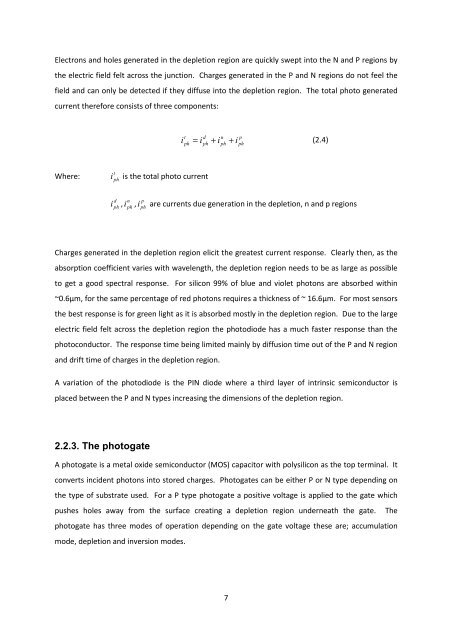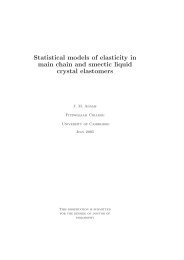Dissertation - FTP Directory Listing - University of Surrey
Dissertation - FTP Directory Listing - University of Surrey
Dissertation - FTP Directory Listing - University of Surrey
You also want an ePaper? Increase the reach of your titles
YUMPU automatically turns print PDFs into web optimized ePapers that Google loves.
Electrons and holes generated in the depletion region are quickly swept into the N and P regions bythe electric field felt across the junction. Charges generated in the P and N regions do not feel thefield and can only be detected if they diffuse into the depletion region. The total photo generatedcurrent therefore consists <strong>of</strong> three components:i = i + i + i(2.4)tphdphnphpphWhere:tiphis the total photo currenti , i , i are currents due generation in the depletion, n and p regionsdphnphpphCharges generated in the depletion region elicit the greatest current response. Clearly then, as theabsorption coefficient varies with wavelength, the depletion region needs to be as large as possibleto get a good spectral response. For silicon 99% <strong>of</strong> blue and violet photons are absorbed within~0.6µm, for the same percentage <strong>of</strong> red photons requires a thickness <strong>of</strong> ~ 16.6µm. For most sensorsthe best response is for green light as it is absorbed mostly in the depletion region. Due to the largeelectric field felt across the depletion region the photodiode has a much faster response than thephotoconductor. The response time being limited mainly by diffusion time out <strong>of</strong> the P and N regionand drift time <strong>of</strong> charges in the depletion region.A variation <strong>of</strong> the photodiode is the PIN diode where a third layer <strong>of</strong> intrinsic semiconductor isplaced between the P and N types increasing the dimensions <strong>of</strong> the depletion region.2.2.3. The photogateA photogate is a metal oxide semiconductor (MOS) capacitor with polysilicon as the top terminal. Itconverts incident photons into stored charges. Photogates can be either P or N type depending onthe type <strong>of</strong> substrate used. For a P type photogate a positive voltage is applied to the gate whichpushes holes away from the surface creating a depletion region underneath the gate. Thephotogate has three modes <strong>of</strong> operation depending on the gate voltage these are; accumulationmode, depletion and inversion modes.7
















